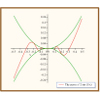Analysis Seminar
This lecture will concern the analysis of thin elastic films which exhibit residual stress at free equilibria, studied through a variational model, pertaining to the non-Euclidean (incompatible) version of the nonlinear elasticity.
We will explain the basic model and the analytical problems which emerge from its study. In particular, we will discuss the rigidity and flexibility properties of the weakly regular solutions to the Monge-Ampère equation; which comes up as the natural constraint space for the dimensionally reduced energy models. We will also discuss the connections with isometric immersion problem.
A $C^2$ solution $u$ to the Monge-Ampère equation in two dimensions with a positive Hessian determinant is necessarily convex. Similarly, if the Hessian determinant of $u$ vanishes, the graph of $u$ is necessarily developable. In these examples, convexity and developability are the two global characteristics of the given solution displaying its rigidity.
As mentioned above, we will explore rigidity and flexibility of the weak type solutions to the Monge-Ampère equation by replacing the Hessian determinant with its other weaker variants. Following convex integration method a la Nash and Kuiper, we show that fixing the weak Hessian determinant as a regular enough distribution, its $C^1$ solutions are dense in the space of all continuous functions (and hence they do not admit the same rigidity as the stronger solutions).
